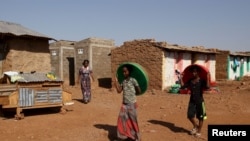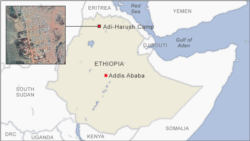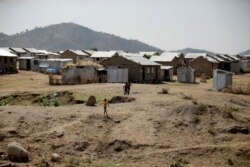Tens of thousands of refugees from Eritrea are at risk of contracting the coronavirus after the first case was found in one of Ethiopia's largest refugee camps. Experts and humanitarian workers say conditions in four northern camps holding approximately 100,000 Eritrean refugees are ideal for the virus to spread with people living close to each other in confined spaces.
Authorities in Ethiopia are racing to improve health facilities and water levels at the country’s 26 refugee camps after the government confirmed that a 16-year-old girl from Eritrea had tested positive for the coronavirus last week.
The patient has since been transferred to a government hospital where she is in stable condition, said Ann Encontre, country representative for the U.N. refugee agency in Ethiopia.
The girl lives in the Adi-Harush camp, which houses about 33,000 people. Samples from two more suspected cases from the camp, located in the Tigray region, are currently under examination at a government laboratory.
Ethiopia’s Administration for Refugee and Returnee Affairs (ARRA) has worked with the U.N. to increase the amount of water at camp sites in the Tigray region to an average of 15 liters per person per day, closer to the necessary 21 liters the U.N. recommends.
Encontre told VOA via a messaging app that containing the spread of the virus will be a challenge considering the living conditions at refugee camps.
“It’s really tight accommodation, tight normal social and cultural practices. So, in all honesty we are fairly confident we have done our best but we have to continue our efforts. We cannot let our hands down now," she said. "We really have to keep the standards…and brainwash basically that this has to be more than ever important to daily living. But the sheer numbers will be a challenge. Some of our camps are 80,000 and above.”
Encontre also said there was a big risk of new cases from Eritrea.
"Ethiopia continues to be a welcoming country to asylum seekers and people running to save their lives for safety and security. And we do have people who are coming across the borders there. The borders are porous," she said.
Ethiopia has recorded more than 2,500 COVID-19 cases and 35 deaths since the first case was confirmed on March 13, although most of those have emerged in the last two weeks. COVID-19 is the disease caused by the coronavirus.
In January, the government stopped granting automatic asylum to Eritreans in an effort to reduce what it deemed to be a “high influx of unaccompanied minors, illegal migrants and others who do not fulfill the criteria laid [out] for refugee status.” Aid groups have said the policy will force Eritreans wishing to flee their homeland to take the dangerous northern route, toward Libya and Europe.
Dan Connell, a visiting researcher at Boston University and an expert on Eritrean refugees, says Ethiopia also changed its policy toward Eritrean refugees in January by issuing more residency permits for refugees to leave the camps.
“They went into the camps and they offered out of camp permits to anyone who wanted it. I was told while I was there in February by ARRA that some 5,000 people had accepted it within the first three weeks that it was offered,” he said.
The policy is designed to reduce the size of the camps so authorities can eventually close a camp known as Hitsats, which holds around 13,000 people, has less amenities than the other three camps in Tigray and is located in an area with high levels of malaria.
“Once you get the virus moving within those camps, the problem gets compounded by the fact that there are many people on the camps distrusting the authorities, and not checking in when they do get sick,” said Connell.
Connell also said there was no way to social distance inside many camps and that there are still “significant numbers” of people coming from Eritrea who are not being counted by the government or U.N.










